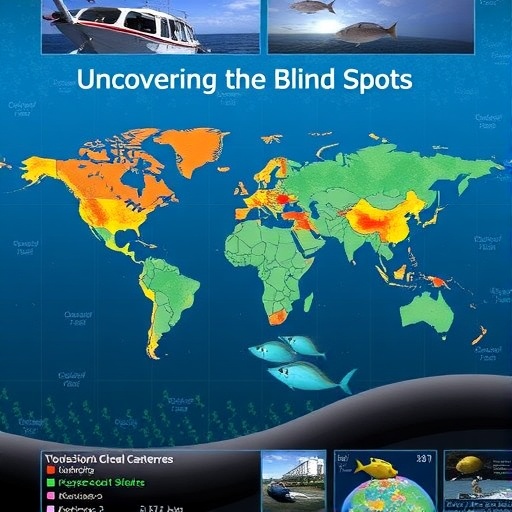
Despite more than a century of oceanographic study and exploration, the vastness of the ocean continues to conceal fundamental mysteries about where marine life dwells and the ecological forces shaping its distribution. A groundbreaking new study published in Communications Earth & Environment sheds light on just how fragmentary and uneven our knowledge of global marine biodiversity truly is, revealing profound biases and glaring gaps that challenge our assumptions about ocean life.
The research team undertook an unprecedented analysis of nearly 19 million biodiversity records compiled in the Ocean Biodiversity Information System (OBIS), the largest global repository of marine species occurrence data. Their meticulous data processing delineated between benthic (seafloor) and pelagic (open water) zones, a crucial partition often overlooked in large-scale assessments. This distinction allows for more targeted understanding of the spatial and taxonomic coverage of ocean biodiversity data, exposing systemic imbalances that risk skewing ecological interpretations and conservation strategies.
Remarkably, their results revealed that although the global seafloor extends thousands of meters in depth covering almost the entire ocean basin, 50% of benthic biodiversity records are disproportionately concentrated in the shallowest 1% of the seafloor, particularly areas less than 30 meters deep. These shallow waters, often accessible to divers and researchers, have become overrepresented in biodiversity datasets, while the vast expanses of the deep ocean remain largely uncharted in biological terms. This shallow water bias not only narrows the biological picture but also underrepresents some of the planet’s most ecologically significant and vulnerable habitats.
.adsslot_xP6KV0DIG8{width:728px !important;height:90px !important;}
@media(max-width:1199px){ .adsslot_xP6KV0DIG8{width:468px !important;height:60px !important;}
}
@media(max-width:767px){ .adsslot_xP6KV0DIG8{width:320px !important;height:50px !important;}
}
ADVERTISEMENT
Moreover, the geographic distribution of data was heavily skewed towards the Northern Hemisphere, accounting for over 75% of the records analyzed. This concentration reflects historical and logistical biases in scientific sampling driven by the location of developed nations, research institutions, and funding agencies. Consequently, large swathes of the southern hemisphere’s oceans, including biodiverse regions surrounding Antarctica, remain overlooked. Particularly, the Areas Beyond National Jurisdiction (ABNJ) — international waters beyond any country’s sovereignty — suffer from critical under-sampling, preventing accurate assessment of biodiversity in these vast, remote, and ecologically vital oceanic zones.
Adding another layer to the complexity of these biases is the taxonomic imbalance in current datasets. Vertebrates, chiefly fish, dominate marine life records, overshadowing the immense diversity of invertebrates. Invertebrates constitute the majority of marine species, performing indispensable roles in ecosystem functioning, nutrient cycling, and food web dynamics. Yet, their representation in global biodiversity data remains shockingly sparse, impeding our ability to model ecosystem resilience or predict responses to anthropogenic pressures such as climate change, pollution, and overfishing.
The implications of such uneven biodiversity data are far-reaching. Biodiversity records underpin conservation planning, habitat protection policies, ecological modeling, and climate impact assessments. Inaccurate or incomplete understanding risks misinforming management strategies, leaving key species and habitats vulnerable, especially in the face of accelerating ocean changes. This study underscores the urgent need for a systematic and equitable global effort to fill the glaring data voids and develop comprehensive, balanced datasets that truly reflect the ocean’s complex biodiversity tapestry.
Accomplishing this, the research team devised a novel analytical pipeline to clean and segregate the OBIS data into benthic and pelagic components, enabling more refined ecological analyses. This technical innovation facilitates the identification of priority gaps in sampling and supports targeted planning of future research expeditions. While this may seem a technical detail, it marks a significant leap toward operationalizing big-data approaches in marine ecology, transforming massive and unwieldy biodiversity databases into actionable scientific tools.
Based on their findings, the authors advocate for a strategic redirection of ocean biodiversity sampling efforts. They emphasize focusing on four critical priorities: first, the deep ocean zones exceeding 1500 meters in depth, which harbor unique ecosystems such as hydrothermal vent communities and abyssal plains; second, the southern hemisphere and its underexplored marine provinces; third, invertebrate taxa that vastly outnumber vertebrates in species richness yet are vastly underrepresented; and fourth, the international waters beyond any single nation’s jurisdiction, which are essential from a governance and conservation standpoint.
The study’s repercussions resonate strongly with global ambitions such as the United Nations Decade of Ocean Science for Sustainable Development and the ambitious 30×30 biodiversity target — the goal to protect 30% of the planet’s marine and terrestrial habitats by 2030. Without addressing the stark inequities in marine biodiversity data, such initiatives risk becoming symbolic rather than effective, as critical regions and organisms remain invisible in scientific and policy frameworks.
Dr. Amelia Bridges, the lead author and Research Fellow at the University of Plymouth, encapsulates the study’s significance: “Our findings show just how uneven our knowledge of ocean life really is, and that has major implications for how we protect it. If we want to manage the ocean sustainably, we first need to understand where life exists, and right now, we’re working with an incomplete map.” Her remarks highlight that this research is not merely about cataloging; it is about empowering a more precise and equitable stewardship of ocean biodiversity in an era of rapid environmental change.
Supporting this perspective, Professor Kerry Howell, Deep-Sea Ecology professor at the University of Plymouth and Plymouth Marine Laboratory, emphasizes the practical utility of the study: “This research will now help guide the work being done under the UN Ocean Decade Challenger 150 Programme, a global cooperative of deep-sea scientists aiming to map life in the deep ocean.” By identifying specific data voids, the study offers a roadmap for future expeditions, optimizing resources and enabling collaborative international efforts to close knowledge gaps in the most challenging marine environments.
Technically, the integration of massive biodiversity datasets like OBIS with novel data processing pipelines exemplifies the emerging frontier of big data in marine science. The ability to sift through millions of records, cleanse and categorize them by ecological zone and taxonomic group, and then quantify geographical and depth-related biases is a monumental computational achievement. It also signals a methodological paradigm shift, where interdisciplinary teams harness data science, oceanography, and ecology to distill clarity from vast and complex biological datasets.
Furthermore, the study stimulates a broader conversation about equity in marine science, highlighting how geopolitical dynamics, funding mechanisms, and infrastructure disparities shape the global scientific landscape. Addressing southern hemisphere and international waters’ underrepresentation will require not just technical solutions, but international collaboration, capacity building, and shifts in research priorities that embrace inclusivity and shared stewardship of the oceans.
In sum, this pivotal study acts as both a mirror and a beacon — a reflection of the disjointed and incomplete state of marine biodiversity knowledge, and a guidepost pointing toward a more connected, comprehensive, and sustainable future for ocean science. It underscores that the path to truly understanding and protecting the ocean begins with filling in the missing pieces of its biological puzzle, transforming fragmented datasets into a complete, vibrant map of life beneath the waves.
Subject of Research:
Not applicable
Article Title:
Prioritisation of ocean biodiversity data collection to deliver a sustainable ocean
News Publication Date:
18-Jun-2025
Web References:
http://dx.doi.org/10.1038/s43247-025-02442-7
Keywords:
Marine biodiversity; Species diversity; Biodiversity loss; Biodiversity; Ecological diversity; Environmental sciences; Aquatic ecology; Applied sciences and engineering; Oceans; Sea floor; Oceanography; Marine biology; Marine ecology
Tags: benthic versus pelagic zonesConservation strategies for marine lifeecological data gaps in oceanographyglobal marine biodiversity studyglobal ocean biodiversity biasesmarine life distribution mysteriesmarine species occurrence dataOcean Biodiversity Information System analysisseafloor biodiversity researchshallow water biodiversity concentrationsystemic imbalances in ecological datauneven distribution of marine life



